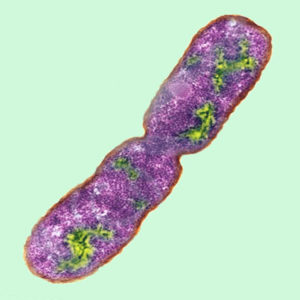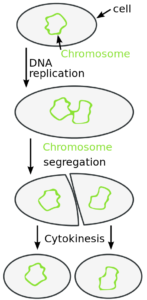37 Prokaryotic Cell Division
The cell division process of prokaryotes (such as E. coli bacteria) is called binary fission. For unicellular organisms, cell division is the only method to produce new individuals. The outcome of this type of cell reproduction is a pair of daughter cells that are genetically identical to the parent cell. In unicellular organisms, daughter cells are whole individual organisms. This is a less complicated and much quicker process than cell division in eukaryotes. Because of the speed of bacterial cell division, populations of bacteria can grow very rapidly.

To achieve the outcome of identical daughter cells, there are some essential steps. The genomic DNA must be replicated (using DNA replication) and then one copy must be moved into each of the daughter cells. The cytoplasmic contents must also be divided to give both new cells the machinery to sustain life. In bacterial cells, the genome consists of a single, circular DNA chromosome; therefore, the process of cell division is very simple.

References
Unless otherwise noted, images on this page are licensed under CC-BY 4.0 by OpenStax.
OpenStax, Biology. OpenStax CNX. May 27, 2016 http://cnx.org/contents/s8Hh0oOc@9.10:Vbi92lHB@9/The-Cell-Cycle
OpenStax, Biology. OpenStax CNX. May 27, 2016 http://cnx.org/contents/s8Hh0oOc@9.10:LlKfCy5H@4/Prokaryotic-Cell-Division


Feedback/Errata